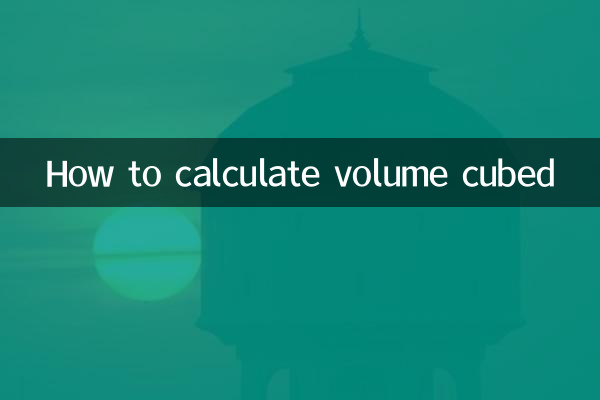Title: How to calculate volume cubed
Introduction:Recently, "How to calculate the volume cube" has become a hot search topic, triggering widespread discussion especially among students, engineers and DIY enthusiasts. This article combines the hot content of the entire network in the past 10 days, systematically introduces the calculation method of volume, and provides structured data to assist understanding.
1. Basic concept of volume

Volume is the size of the three-dimensional space occupied by an object, and its units are cubic meters (m³), cubic centimeters (cm³), etc. The calculation method varies depending on the shape of the object. The following is the volume formula of common geometric objects:
| shape | volume formula | Example |
|---|---|---|
| cube | Side length³ | Side length is 2m, volume = 8m³ |
| cuboid | Length×width×height | 3m long, 2m wide, 1m high, volume = 6m³ |
| cylinder | π×radius²×height | Radius 1m, height 4m, volume ≈ 12.57m³ |
| sphere | (4/3)π×radius³ | Radius 2m, volume≈33.51m³ |
2. Recent popular application scenarios
1.Home decoration:Netizens are hotly discussing how to calculate the volume of a room to choose air conditioning or heating equipment.
2.Logistics and transportation:During e-commerce promotions, how to accurately calculate the volume of goods becomes the key to reducing shipping costs.
3.Educational exams:The mathematics test questions were combined with the theme of environmental protection, requiring the calculation of water tank capacity to trigger discussion.
3. Comparison of practical calculation tools
| Tool name | Features | Applicable platforms |
|---|---|---|
| GeoGebra | Visual 3D modeling calculation | Web page/APP |
| Wolfram Alpha | Support complex geometry calculations | web page |
| Volume Calculator APP | Scan the QR code to measure the physical volume | Android/iOS |
4. Frequently Asked Questions
Q: How to calculate the volume of irregular objects?
A: Drainage method (immersed in water to measure water level changes) or 3D scanning technology can be used.
Q: How to convert cubic meters to liters?
A: 1 cubic meter = 1000 liters, 1 liter = 0.001 cubic meter.
5. Things to note
1. Units need to be unified when calculating, and avoid mixing different units such as meters and centimeters.
2. The concave and convex error on the object surface needs to be considered during actual measurement.
3. It is recommended to retain 3 significant figures in engineering applications.
Conclusion:Mastering volume calculations can not only solve practical problems in learning and work, but also cultivate spatial thinking skills. It is recommended to choose an appropriate calculation method based on specific needs, and use professional tools to improve accuracy when necessary.

check the details

check the details